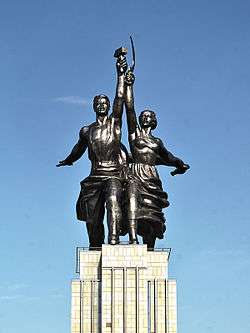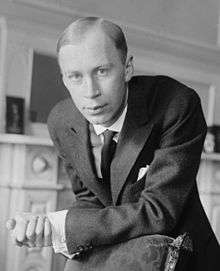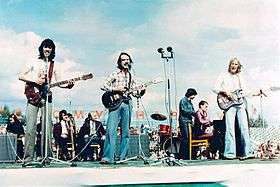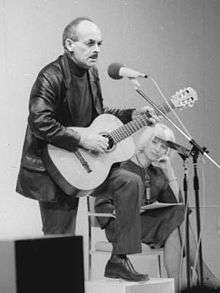Music of the Soviet Union
Music of the Soviet Union varied in many genres and epochs. The majority of it was considered to be part of the Russian culture, but other national cultures from the Republics of the Soviet Union made significant contributions as well. The Soviet state supported musical institutions, but also carried out content censorship. According to Lenin, "Every artist, everyone who considers himself an artist, has the right to create freely according to his ideal, independently of everything. However, we are Communists and we must not stand with folded hands and let chaos develop as it pleases. We must systemically guide this process and form its result."[1]
| Part of a series on the |
| Culture of the Soviet Union |
|---|
 |
| People |
| Languages |
| Traditions |
| Cuisine |
| Festivals |
|
Art |
| Literature |
|
Music and performing arts |
| Sport |
|
Monuments |
|
Symbols
|
|
Classical music of the USSR

Classical music of the Soviet Union developed from the music of the Russian Empire. It gradually evolved from the experiments of the revolutionary era, such as orchestras with no conductors, towards classicism favored under Joseph Stalin's office.
The music patriarchs of the era were Prokofiev, Shostakovich and Aram Khachaturian. With time, a wave of younger Soviet composers, including Georgy Sviridov, Tikhon Khrennikov, Alfred Schnittke managed to break through.
Many musicians from the Soviet era have established themselves as world's leading artists: violinists David Oistrakh, Leonid Kogan, Gidon Kremer, Viktor Tretyakov and Oleg Kagan; cellists Mstislav Rostropovich, Daniil Shafran, and Natalia Gutman; violist Yuri Bashmet; pianists Sviatoslav Richter, Emil Gilels and many other musicians.
Music in Stalin's early years
After Joseph Stalin had succeeded in expelling Leon Trotsky from the Central Committee in 1927, he very soon cut off connections with the West and established an isolationist state. Stalin rejected Western and its ‘bourgeois principles,’ as these did not agree with the values of the Soviet Communist Party or the working class. The Association of Contemporary Musicians (ACM), a faction of more progressive Soviet musicians, who had thrived from exposure to the West during the NEP years, quickly dissolved without the support of the worker’s state. Former members of the ACM joined the Russian Association of Proletarian Musicians (RAPM). The RAPM, composed of ‘reactionary proletarians,’ opposed Western music ideals, instead seeking to encourage traditional Russian music.[2] Conflict between reactionaries and progressives (former ACM members) within the RAPM ensued. Although the Communist Party supported the reactionaries, it did not directly act to resolve the conflict; the party’s attention during this period was instead focused on the USSR’s economic development.[3] In 1932, the RAPM was disbanded in favor of a new organization: the Union of Soviet Composers (USC).
Stalin's Second Revolution of 1932
The year 1932 marked a new cultural movement of Soviet nationalism.[4] The party pursued its agenda through the newly founded Union of Soviet Composers, a division of the Ministry of Culture. Musicians who hoped to gain the financial support of the Communist Party were obligated to join the USC. Composers were expected to present new works to the organization to be approved before publication. The USC stated that this process aimed to guide young musicians to successful careers. Thus, through the USC, the Communist Party was able to control the direction of new music.
Stalin applied the notion of socialist realism to classical music. Maxim Gorky had first introduced socialist realism in a literary context in the early 20th century. Socialist realism demanded that all mediums of art convey the struggles and triumphs of the proletariat. It was an inherently Soviet movement: a reflection of Soviet life and society.[5] Composers were expected to abandon Western progressivism in favor of simple, traditional Russian and Soviet melodies. Additionally, music served as a powerful propaganda agent, as it glorified the proletariat and the Soviet regime. Stalin’s greatness became a theme of countless Soviet songs, a trend of which he attempted to stop on more than one occasion.[6] Communist ideals and promotion of the party were thus the foundations of this cultural movement.
Ivan Dzerzhinsky's opera, Tikhii Don, composed in 1935 became the model for socialist realism in music. Upon seeing the opera, Stalin himself praised the work, as it featured themes of patriotism while utilizing simple, revolutionary melodies.[7] Composers were writing for a proletarian audience; Dzerzhinsky’s Tikhii Don met this expectation. On the other hand, Shostakovich’s opera, Lady Macbeth of the Mtsensk District, first performed in 1934, resulted in disaster for the prodigious composer. Although Shostakovich’s work was initially critically well received, Stalin and the Communist Party found the opera’s themes of a “pre-socialist, petty-bourgeois, Russian mentality” entirely inappropriate.[8] Pravda, a state-sponsored newspaper, harshly criticized Shostakovich’s opera. Thus, these two operas provided composers with an indication of the direction the Communist Party planned to lead Soviet music. Soviet music should have been music the common workingman could understand and take pride in. This marked a stark change in party policy from the unrestricted freedoms of the early Soviet years.
Classical Music during the Second World War
The Nazi invasion of the Soviet Union in June 1941 came as a complete surprise to most Soviets. Stalin’s administration was forced to react quickly and devote all its resources into the war effort. As a result, Soviet music witnessed a relaxation of restrictions on expression. This period was a break from the policies of the 1930s. The Communist Party, seeing as it was allied with several Western powers, focused on patriotic propaganda rather than anti-Western rhetoric. With a restored connection to the west, Soviet music experienced a new wave of progressivism and experimentation.[9]
Composers responded to their new freedoms with music laden with themes of patriotism and military triumph. Wartime music featured a reemergence of grand symphonic works compared to the simplistic ‘song operas’ (such as Tikhii Don) of the 1930s.[9] Sergei Prokofiev, Nikolai Miaskovsky, Aram Khachaturian and Shostakovich each composed war symphonies. Chamber music, a genre that had fallen out of favor in the previous decade, was also revitalized. Wartime music aimed to boost Soviet morale both at home and on the battlefront, and it was successful, especially as the Soviet army began to gain momentum against the Nazis in 1942.[10]
Zhdanovism and a return to the policies of the 1930s
Following the end of the war, the Communist Party refocused on isolationism and culture control. Stalin appointed Andrei Zhdanov in 1946 to carry out this return to the policies of the 1930s. Zhdanovism meant a reemphasis on socialist realism, as well as anti-Western sentiment.[11] The Communist party again encouraged composers to incorporate themes of the Russian Revolution, as well as nationalist tunes. Zhdanov castigated composers on an individual basis, particularly Prokofiev and Shostakovich, for embracing Western ideals during the war. Tikhon Khrennikov, meanwhile, was appointed head of the Union of Soviet Composers. Khrennikov would become one of the most despised figures among Soviet musicians, as the USC embraced a greater role in censorship.[12]
Reaction to the Communist Party’s restrictions varied with the different generations of composers. The younger generation largely strove to conform, although the music they produced was simplistic and bare in structure.[12] Desperate to find acceptable melodies, composers incorporated folk tunes into their music. Some composers, Prokofiev and Shostakovich included, turned to film music. Shostakovich, among others, withheld his more expressive and perhaps controversial works until after Stalin’s death.[13] Shostakovich was honored by Stalin and the Soviets for his brilliant music, and was never executed, despite Stalin not liking the direction some of his music took. The complex tonal structures and progressive themes that were prevalent during the war slowly disappeared.[12] The years after the war and prior to the cultural Thaw under Nikita Khrushchev thus marked a rapid decline in Soviet music.
Film soundtracks
Film soundtracks produced a significant part of popular Soviet/Russian songs of the time, as well as orchestral and experimental music. During the 1930s, Sergei Prokofiev's composed scores for Sergei Eizenshtein films, such as Alexander Nevsky, and also soundtracks by Isaak Dunayevsky that ranged from classical pieces to popular jazz. Among the pioneers of Soviet electronica was 1970s ambient composer Eduard Artemiev, best known for his scores to science fiction films by Tarkovsky. Many films produced in the Soviet Union were patriotic in nature and the music in such films also carried a positive tone of Soviet pride, incorporating aspects of folk music and other Russian musical influences, in addition to the influences of the ethnic communities that made up the federal state's 14 other republics.
Popular music
Early Soviet years
Popular music during the early years of the Soviet period was essentially Russian music. One of the most well-known songs "Katyusha" by Matvei Blanter is close to the melodic, rhythmic, and harmonic structures of Russian romantic songs of the 19th century.[14] It was an adaptation of folk motifs to the theme of soldiers during wartime.[15]
Many of the most frequently performed songs in Soviet Russia came from the international revolutionary movement of the late 19th and early 20th centuries. A noteworthy example is the song "Varshavianka", which originated in Poland and became popularized with the Russian Revolution. The song is characterized by an intense rhythm and calls for "To bloody battle, holy and righteous." There was also the song "The Red Banner" (Красное Знамя) which originated in France. One of the most commonly known songs is "Boldly, Comrades, in Step" (Смело, товарищи, в ногу) and the funeral march "You Fell Victim" (Вы жертвою пали).[16]
In the 1930s, songs from films became highly popular. They include If Tomorrow Brings War (Если завтра война) and Three Tankmen (Три Танкиста) by the Pokrass brothers and Tachanka by Listov, which have patriotic themes.[17]
Soviet music
In the official Soviet musicology, "Soviet music is a qualitatively new stage of the development of musical arts." It was based on the principles of Socialist Realism and formed under the immediate control and sponsorship of the Soviet state and the Communist Party of the Soviet Union.[18]
Soviet song
Main categories recognized by Soviet musicology within the Soviet song were mass song, "stage song" (estradnaya pesnya), and "everyday song" (bytovaya pesnya).[19]
1930-1960s: Soviet jazz

Jazz music was introduced to Soviet audiences by Valentin Parnakh in the 1920s. Singer Leonid Uteosov and film score composer Isaak Dunayevsky helped its popularity, especially with the popular comedy film Jolly Fellows that featured a jazz soundtrack. Eddie Rosner, Oleg Lundstrem, Coretti Arle Titz and others contributed to Soviet jazz music.
In the late 1940s, during the "anti-cosmopolitanism" campaigns, jazz music suffered from ideological oppression, as it was labeled "bourgeois" music. Many bands were dissolved, and those that remained avoided being labeled as jazz bands.
In the 1950s underground samizdat jazz journals and records became more common to disseminate musical literature and music.[20]
However, in the early 1960s during the "Khrushchev Thaw", Soviet Jazz saw a minor comeback. Further information:
Soviet Estrada
The term "Estrada artists" in the Soviet period usually referred to performers of traditional Popular music (although the actual term Estrada (stage) is much wider) accompanied by symphony orchestras (with occasional choral backup). They sang songs written by professional composers and poets/songwriters. The songs were designed for vocal prowess, had clear, catchy melodies, accompaniment is given to a secondary role. Therefore, on the Soviet еstrada was dominated by solo singers with good vocal abilities, not to play the instrument and its repertoire writing themselves.
Among the artists of the early period were Leonid Utesov (also one of the pioneers of Soviet jazz), Mark Bernes, Lyubov Orlova, Coretti Arle Titz, Klavdiya Shulzhenko, Rashid Behbudov. Among the many artists of the Khrushchev Thaw and the Era of Stagnation were Yuri Gulyaev, Larisa Mondrus, Aida Vedishcheva, Tamara Miansarova, Lidia Klement, Eduard Khil, Lyudmila Senchina, Edita Piekha, Vladimir Troshin, Maya Kristalinskaya, Vadim Mulerman, Heli Lääts, Uno Loop, Anna German, Valery Obodzinsky, Iosif Kobzon, Muslim Magomayev, Lyudmila Zykina, Alla Pugacheva, Valery Leontiev, Sofia Rotaru, Lev Leshchenko, Valentina Tolkunova and Sergey Zakharov. Songs by these artists are often included in the soundtracks for films and television dramas, TV movies and miniseries, and vice versa, for songs from film and TV soundtracks were and are often included in the repertoire of еstrada artists.
As traditional popular music was the main official direction of Soviet estrada, it was subjected to a particularly rigorous censorship. Usually the songs were composed by members of the Union of Composers (the most famous among them being Aleksandra Pakhmutova, Vasily Solovyov-Sedoi, Tikhon Khrennikov, David Tukhmanov, Raimonds Pauls, Yevgeny Krylatov etc.) and song lyrics were written by professional and trustworthy poets and songwriters who also were USC members (Mikhail Matusovsky Vasily Lebedev-Kumach, Nikolai Dobronravov, Robert Rozhdestvensky, Mikhail Tanich, Leonid Derbenyov, Yuri Entin, Ilya Reznik, Grigore Vieru). All this is defined as the high demands on the material and the narrow limits of creativity, especially lyrically. The еstrada songs mostly then were about love, nature or about patriotism, ideology and national pride.
1960-80s: the VIAs

The 1960s saw the rise of the VIA (Vocalno-instrumentalny ansambl, vocal&instrumental ensemble) movement. VIAs were state-produced bands of professional musicians, often performing songs written for them by professional composers and writers of the Union of Composers such as Alexandra Pakhmutova, Yan Frenkel and Raimonds Pauls. Among the most notable VIA bands and vocalists were Pesniary, a folk band from Belarus; Zemliane, Poyushie Gitari, Yuri Antonov with Arax and Stas Namin with Tsvety.
To break through into the mainstream with state-owned Soviet media, any band should have become an officially recognized VIA. Each VIA had an artistic director (художественный руководитель) who acted as manager, producer, and state supervisor. In some bands, namely Pesniary, the artistic director was also the band's leading member and songwriter.
Soviet VIAs developed a specific style of pop music. They performed youth-oriented, yet officially approved radio-friendly music. A mix of western and Soviet trends of the time, VIA combined traditional songs with elements of Rock, Disco and New wave music. Folk music instruments were often used, as well as keytars. Many VIAs had up to ten members including a number of vocalists and multiinstrumentalists, whom were in constant rotation.
Due to state censorship, the lyrics of VIAs used to be "family-friendly". Typical lyrical topics were emotions such as love, joy and sadness. Many bands also praised national culture and patriotism, especially those of national minorities from smaller Soviet republics.
1960-70s: Bard music

The Singer–songwriter movement of the Soviet Union is deeply rooted in amateur folklore songs played by students, tourists and travelling geologists. It became highly popular in the 1960s and was sometimes considered as an alternative to official VIAs. Music characteristics of the genre consist of simple, easily repeatable parties, usually played by a single acoustic guitar player who simultaneously sang. Among the singer-songwriters, termed as "bards", the most popular were Bulat Okudzhava, Vladimir Vysotsky, Yuri Vizbor, Sergey and Tatyana Nikitins. Lyrics played the most important role in Bard music, and bards used to be more like poets than musicians.
1980s: Russian rock
Rock music came to Soviet Union in the late 1960s with Beatlemania, and many rock bands arose during the late 1970s, such as Mashina Vremeni, Aquarium, and Autograph. Unlike VIAs, these bands were not allowed to publish their music and remained underground. The "golden age" of Russian rock is widely considered to have occurred during the 1980s. Censorship mitigated, rock clubs opened in Leningrad and Moscow, and soon rock became mainstream.[21] Popular bands of this time-period included Kino, Alisa, Aria, DDT, Nautilus Pompilius and Grazhdanskaya Oborona. New wave and post punk were also trends in 1980s Russian rock.
See also
Post-Soviet republics
Other states
References
- Lenin, O Kulture i Iskusstve (about Culture and Art), Moscow, 1957, pp 519-520
- Krebs, Stanley D. (1970). Soviet Composers and the Development of Soviet Music. New York: W.W. Norton. p. 49.
- Krebs, Stanley D. (1970). Soviet Composers and the Development of Soviet music. New York: W.W. Norton. p. 50.
- Krebs, Stanley (1970). Soviet Composers and the Development of Soviet Music. New York: W.W. Norton. p. 50.
- Bakst, James (1966). A History of Russian-Soviet Music. New York: Dodd, Mead. p. 286.
- Krebs, Stanley (1970). Soviet Composers and the Development of Soviet Music. New York: W.W. Norton. p. 53.
- Edmunds, Neil (2004). Soviet Music and Society under Lenin and Stalin: the baton and sickle. New York: RoutledgeCurzon. p. 14.
- Krebs, Stanley (1970). Soviet Composers and the Development of Soviet Music. New York: W.W. Norton. p. 52.
- Krebs, Stanley (1970). Soviet Composers and the Development of Soviet Music. New York: W.W. Norton. p. 54.
- Krebs, Stanley (1970). Soviet Composers and the Development of Soviet Music. New York: W.W. Norton. p. 55.
- Schwarz, Boris (1983). Music and Musical Life in Soviet Russia, 1917-1981. Bloomington: Indiana University Press. p. 110.
- Krebs, Stanley (1970). Soviet Composers and the Development of Soviet Music. New York: W.W. Norton. p. 58.
- Krebs, Stanley (1970). Soviet Composers and the Development of Soviet Music. New York: W.W. Norton. p. 59.
- Nicolas Slonimsky. Russian and Soviet music and composers. Psychology Press, 2004. p.164
- James Von Geldern. Mass culture in Soviet Russia: tales, poems, songs, movies, plays, and folklore, 1917-1953. Indiana University Press. p.315
- Amy Nelson. Music for the revolution: musicians and power in early Soviet Russia. Penn State Press. 2004. p.34
- L.V Poliakova. Soviet music. Foreign Languages Pub. House. Moscow. 1961.
- "Soviet Music", Music Encyclopedia (Музыкальная энциклопедия. — М.: Советская энциклопедия, Советский композитор. Под ред. Ю. В. Келдыша. 1973—1982.) (in Russian)
- "Mass Song", Music Encyclopedia (Музыкальная энциклопедия. — М.: Советская энциклопедия, Советский композитор. Под ред. Ю. В. Келдыша. 1973—1982.) (in Russian)
- Culshaw, Peter (2006-10-14). "How jazz survived the Soviets". The Telegraph. Retrieved 2011-07-01.
- Walter Gerald Moss. A History Of Russia: Since 1855, Volume 2. Anthem Series on Russian, East European and Eurasian Studies. Anthem Press, 2004. 643 pages.
External links
- SovMusic.ru – Soviet music archive
- Music, War and Revolution – a three-part documentary series. Directed by Anne-Kathrin Peitz.
